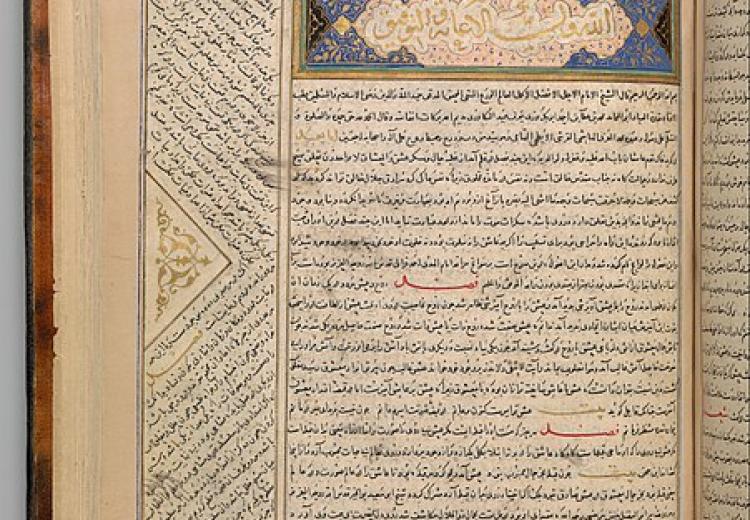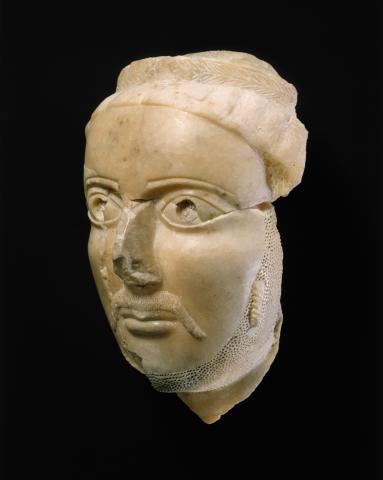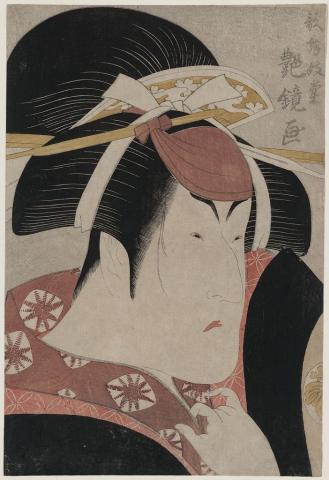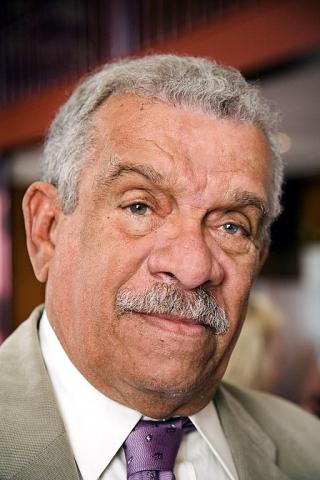National Poetry Month: Celebrating World Poetry

Anthology of Persian poetry from the 15th century.
Inaugurated by the Academy of American Poets in April 1996, National Poetry Month brings together lovers of poetry from around the country to celebrate poetry and its vital place in American culture. In previous years, EDSITEment featured lesson plans and websites about some of America’s most original poets: for example, Maya Angelou (in Introducing Metaphors Through Poetry), Emily Dickinson, Walt Whitman, and Langston Hughes, among others. This year EDSITEment has updated our World Poetry feature to focus on the different poetic forms that have developed across time and around the world.
Epics
Some of the most well known and most important works of world literature are epic poems from antiquity. (For a definition of epic, turn to the EDSITEment literary glossary.) These long, heroic adventure tales in verse have had surprising durability over time. The Greek poet Homer's story of friendship, betrayal, and heroism, the Iliad, continues to captivate modern audiences on stage and in contemporary films such as Troy.
Epic poems are more than simply a lengthy story told in poetic form, however, and their ability to remain accessible, relevant, and memorable over time owes a significant debt to their roots in oral tradition and to their cyclical pattern of events. A Story of Epic Proportions: What makes a Poem an Epic? introduces students to the form and to the oral tradition of the Mediterranean world. Students learn about the epic hero cycle and how to recognize this pattern of events and elements — even in surprisingly contemporary places. Students are also introduced to the patterns embedded in the stories with epics that have helped generations of storytellers remember these immense poems. The Odyssey in Power Point a study guide available from The Examined Life: Greek Studies in the Schools offers a variety of activities and learning experiences that take students from reading and studying the Odyssey, to researching and writing about mythological gods or characters and oral storytelling.
One such contemporary storyteller is the West Indian poet Derek Walcott who has a lifelong fascination with Homer and the sea. This fascination culminated in a retelling of the Odyssey story, set in his homeland Caribbean island of St. Lucia. Walcott, who won the Noble prize for literature in 1992, discusses his work Omeros in this podcast from the BBC.
The great Italian poet Dante Alighieri who lived in Florence at the turn of the 13th century looked back to Homer and the later Roman poet Virgil for literary inspiration when he undertook his own three-part epic about the Christian afterlife, The Divine Comedy. EDSITEment’s A Storybook Romance: Dante's Paolo and Francesca serves as a good introduction to the Comedy by way of one of the most memorable episodes in Dante’s journey through the Inferno. NEH-funded The World of Dante offers the poem in both the Italian original and several English translations. The website also includes galleries of the famous illustrations by Botticelli and Gustave Doré inspired by the poem, maps of Dante’s Europe, and his versions of heaven, hell, and purgatory. There are also recordings of the liturgical chants and hymns mentioned in the Purgatorio and the Paradiso. Dante’s genius was visual as well as verbal and his poetry, especially the Inferno, was hugely influential on many 19th-century French artists such as Doré, the sculptor Auguste Rodin, and poet Charles Baudelaire. (The latter’s darker view into the poetic imagination will appeal to high school students who will revel in 19th-century Paris and the macabre images in EDSITEment lesson, Charles Baudelaire: Poète Maudit (The Cursed Poet). Additional resources for Dante scholarship include the Dartmouth Dante Project and Digital Dante.
The Ramayana
Like the Iliad and the Odyssey, this epic poem from India, the Ramayana, is thought to have been composed more than 2500 years ago, and, was also originally transmitted orally by bards. Tellers of the epic add and delete pieces of the story, or localize the action by entering recognizably regional place names. The Ramayana also changes as it is translated and reconstituted in each of India's many different languages, taking on the new sounds and poetic structures.
While details may evolve in new directions, particularly through these processes of localization and translation, the main tenets of the story remain intact, and this poem continues to be upheld as an example of correct behavior by teaching the listener/reader to live one's dharma. The meaning of the word dharma includes both good and righteous behavior according to one's role in society, as well as the correct performance of that role in any given situation. Following one's dharma will result in the consistent and correct performance of duties, according an individual’s responsibilities and station in life.
Like Homer’s epics for the ancient Greeks, the Ramayana is a foundational book for Hindu culture, serving as a guide that helps past, present, and future generations navigate the code of right and moral behavior. This is one of the main reasons why a story that was composed over two millennia ago has survived and still plays an important role in Indian society. In Lessons of the Indian Epics: Following the Dharma students can explore Hindu culture by examining the characters of the Ramayana, and the choices they make. In the related Lessons of the Indian Epics: The Ramayana: Showing your Dharma, students expand their visual literacy skills by examining visualizations of the poem while gaining insight on the characters and key events of the work.
Arabic Poetry
In ancient Arabia and Persia (modern-day Iran), the Bedouins made poetry a participatory art. Several poetic forms developed from the communal nature of this tribal poetry. The Metropolitan Museum of Art offers a video with a selection of these readings with musical accompaniment, "Powerless Before Love—Arabic And Persian Poetic Traditions." Today in most Arabic cultures, one may still experience public storytelling and spontaneous poetry challenges in the streets. The art of turning a rhyme into sly verbal sparring is considered a mark of intelligence and a badge of honor.
The ghazal (pronounced "guzzle") is an intricate pre-Islamic poetic form that is thought to have developed through the practice of poetic challenges. It is a series of couplets, called shers, no more than a dozen or so, which are related, but not connected in a narrative pattern. The first couplet, or matla, has a rhyme pattern (kaafiyaa) preceding a single word or short phrase refrain (radif) at the end of each line. Thereafter, every couplet shows a pattern wherein the first line doesn't rhyme, but the second line ends in the kaafiyaa and the radif. Finally, the last couplet, the maqta, contains the takhallis, the poet's name or pen-name.
This complex structure requires careful insights and an understanding of irony and word-play. Although ancient, it remains current, forming the lyrical base of much popular music in India, Iraq, and Iran. Students will enjoy discovering the rules of ghazal writing through observation and inference.
Japanese Poetry
Springtime in Japan means hanami, or cherry blossom season. This important aspect of Japanese culture is celebrated by picnicking in the open air, viewing the blossoming trees, and writing nature poetry such as haiku. Haiku present a snapshot of everyday experience, revealing an unsuspected significance in a detail of nature or human life. Haiku poets find their subject matter in the world around them, not in ancient legends or exotic fantasies. They write for a popular audience and give their audience a new way to look at things they may not have noticed in the past.
This same point of view can be found in traditional Japanese woodblock prints (called "ukiyo-e" which means “pictures of the floating or sorrowful world”) Like haiku, these distill a timeless beauty from the constantly shifting scene of daily life. For examples of woodblock prints that can help students visualize the world of haiku, visit the Metropolitan Museum, Heilbrunn Timeline slideshow: Woodblock Prints in the Ukiyo-e Style. The Library of Congress offers an exhibition, The Floating World of Ukiyo-e, with selected prints from their collection that includes background on Japanese cultural allusions and literary sources found within these images.
Several lessons will guide students into selected resources on the poetry and culture of Japan and instruct them in the writing of haiku and other forms of Japanese poetry. Elementary school students share in the spirit of this timeless ritual with EDSITEment lesson "Can You Haiku?" A Journey to Japan Through Poetry lesson can be accessed through Yale-New Haven Teachers Institute. Middle school students can open up the World of Haiku, while older students try their hand at other forms of Japanese Poetry in Tanka? You’re Welcome! and Say Hi to Haiban Fun: all three found on EDSITEment.
Students will be amused to learn What Makes the Japanese Laugh? Art of Word Play and Storytelling from the AsiaSociety. They will have fun manipulating ArtsEdge’s Playing with Shadows, an interactive resource in which they will learn about the ancient art of Asian shadow puppetry, then create their own! For poetic inspiration, play a podcast from the EDSITEment-selected resource, AsiaSociety such as Between Tides: Chamber Music from Japan while the class is writing. An interactive journey into world of the 20th-century Japanese American sculptor Noguchi as well as a preview of the highlights of the Japanese Art collection at the Smithsonian's Freer Sackler Galleries will stimulate students to delve further into traditional and modern Japanese art.
World Poetry Sites
Various organizations are devoted to using poetry to bridge the cultural divide within communities in America as well as worldwide. City Lore hosts the People’s Poetry Project "to systematically present the diverse oral poetry traditions of New York City, the U.S. and beyond." Their Endangered Poetry Initiative was developed to focus on contested and endangered languages. They created a digital version of a travelling exhibition, Poetic Voices of the Muslim World, to increase Americans' understanding of Muslim poetic traditions in oral and literary forms.
In 1999, World Poetry Day was designated by the UN UNESCO as an annual celebration to be held on March 21 with "the aim of supporting linguistic diversity through poetic expression and increasing the opportunity for endangered languages to be heard." The website offers recommendations on teaching poetry in secondary schools with many world poets across the globe sharing their insights into how to engage young people with poetry.
The Poetry Foundation, through its online magazine, podcasts, and videos also serves up poetry and cultural insights from the far corners of the globe. For 2017 World Poetry Day, the Foundation shared TIME magazine "Presents 30 Portraits of Poets for World Poetry Day." The Academy of American Poets offers a list of international poetry organizations and festivals involved in promotion of world poetry on their World Poetry Day: March 21 feature. This year, the Poetry Foundation and the Academy of American Poets have partnered with a number of other literary and cultural organization to form a national Poetry Coalition around the theme: Because We Come From Everything presenting programs and projects on the theme of poetry and migration. PBS NewsHour offers video clips with "Because We Come From Everything" poets sharing their immigration stories in their Art Beat article.
World Poetry in the Media
Poets serve a special function within countries around the world by acting as visionaries and keepers of the flame as well as “troublemakers”—exposing often uncomfortable truths about their societies. Three poets from different cultures speak of their experiences, revealing how poetry operates differently in cultures on the world stage in an NPR broadcast interview from Talk of the Nation: Poets Tell the Stories of their Countries. Students may watch a video clip available from the PBS Newshour Poetry series archive of transplanted poet, Li-Young Lee, as he shares his work and his experience coming to America as an immigrant from Indonesia and reads from his poem: “Self-Help for Fellow Refugees,”
If your name suggests a country where bells
might have been used for entertainmentor to announce the entrances and exits of the seasons
or the birthdays of gods and demons,it’s probably best to dress in plain clothes
when you arrive in the United States,
and try not to talk too loud …
Featured Lessons
- All Together Now: Collaborations in Poetry Writing
- Animal Farm: Allegory and the Art of Persuasion
- Animating Poetry: Reading Poems about the Natural World
- Arabic Poetry: Guzzle a Ghazal!
- The Beauty of Anglo-Saxon Poetry: A Prelude to Beowulf
- Can You Haiku?
- Carl Sandburg’s “Chicago”: Bringing a Great City Alive
- Charles Baudelaire: Poète Maudit (The Cursed Poet)
- Chaucer's Wife of Bath
- Edward Hopper's House by the Railroad: From Painting to Poem
- Edward Lear, Limericks, and Nonsense: There Once Was …
- Emily Dickinson & Poetic Imagination: “Leap, plashless”
- The Impact of a Poem's Line Breaks: Enjambment and Gwendolyn Brooks’ “We Real Cool”
- Introducing Metaphors Through Poetry
- Introduction to Modernist Poetry
- Jacob Lawrence’s Migration Series: Removing the Mask
- Japanese Poetry: Tanka? You're Welcome!
- Listening to Poetry: Sounds of the Sonnet
- Midnight Ride of Paul Revere—Fact, Fiction, and Artistic License
- Play with Words: Rhyme & Verse
- Poems that Tell a Story: Narrative and Persona in the Poetry of Robert Frost
- The Poet's Voice: Langston Hughes and You
- Poetry of The Great War: 'From Darkness to Light'?
- Preparing for Poetry: A Reader's First Steps
- Recognizing Similes: Fast as a Whip
- Seeing Sense in Photographs & Poems
- A Story of Epic Proportions: What makes a Poem an Epic?
- Walt Whitman to Langston Hughes: Poems for a Democracy
- Walt Whitman's Notebooks and Poetry: the Sweep of the Universe
- The World of Haiku





